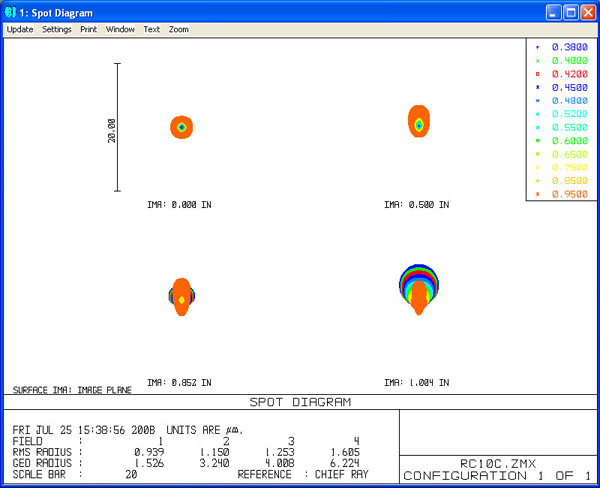RC10C Ritchey-Chrétien Astrograph
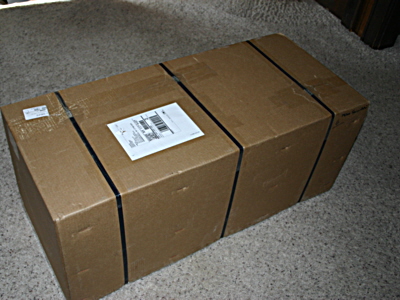
|

|
| The thick walled box arrived in perfect shape. |
The OTA is suspended is a semi-soft custom mold. |
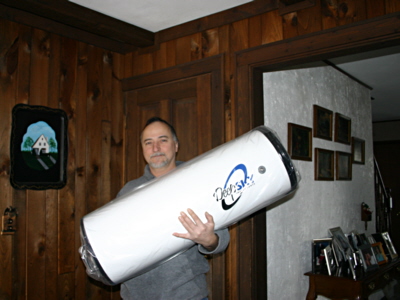
|
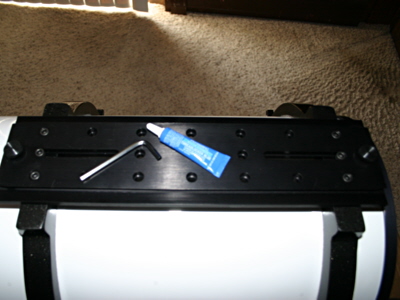
|
| Weighing in at 30 pounds this tube is portable. | The OTA is secured in a set of Parallax rings mounted on a 15" ADM mounting plate for a flex free mounting. |

|
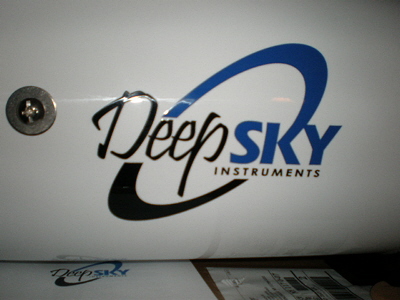
|
| The body is constructed of reinforced phenolic resin tubing material using automotive finishing techniques. Phenolic resin construction is not as costly as carbon fiber and much more thermally stable than aluminum. |
Close up shows the smooth surface with a clear coat. The large stainless steel screw is part of the secondary mounting. |
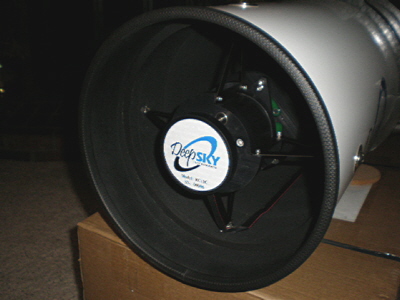
|
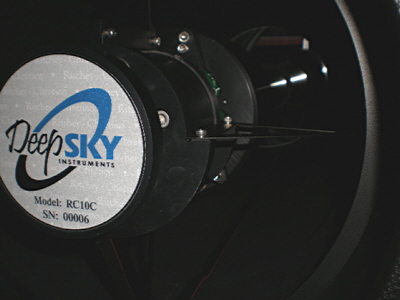
|
| Front view showing the tube edging finish. | Close up of the focuser unit and secondary mirror assembly. The center of the secondary has a small collimation circle for alignment assist. The thickness of the spiders produces mild diffraction spikes on bright stars. The green circuit board is the dew heater if you should need it. |
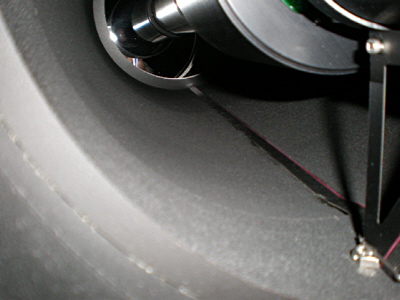
|
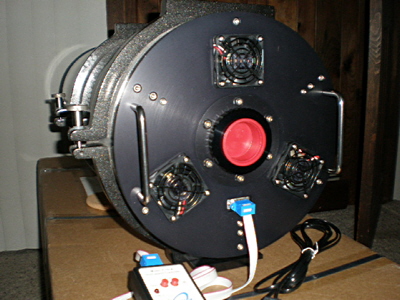
|
| Interior of OTA is finished with a course textured flat black surface to minimize light scatter. Seen in the rear is an aperture ring that assists in keeping air flow across the mirror surface when the fans are on and also minimizes any mirror edge associated diffraction artifacts. The black ribbon wire carries the signals for the fans, dew heater and focuser. | Rear of the OTA with the IC101-A controller. The fans and dew heater can be controlled from the IC101A or through the ASCOM driver. The rear is threaded to accept 2.74" Astro Physics adapters. Shown is the Astro Physics thin profile 2" adapter. The fans are positioned to draw air out the back of the tube. |
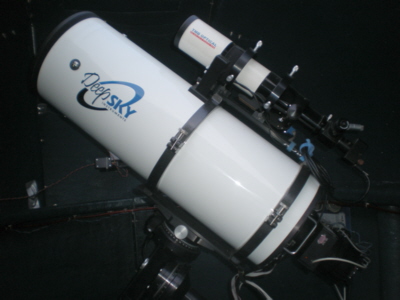
|
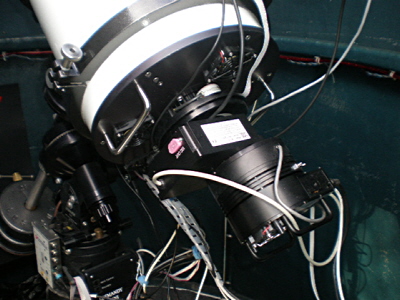
|
| RC10C with piggyback TMB-80SS wide field scope. | Rear view showing Pyxis rotator, AO-8, CFW8 and ST2000XM. All components are direct attached. An Astro Physics low profile 2.74-2" adapter secures the equipment with 3 allen screws for a rigid mount. The total spacing is such that the focal point is 6.1" from the back of the backing plate. This is within the recommended 6.0+/- 0.25" back focus requirements. |
Focuser Evaluation-
The next evaluation of the RC10C is the focuser performance. Like a low cost mount, a poorly designed or built focuser can cause many headaches. One benefit of having a secondary mirror focuser is there is no weight, other than the mirror, to make the focuser slip or sag with the latter leading to image shift. The focuser has a physical range of about 1 1/4” and a focal plane of about 2 1/4". The focuser half-steps are 0.005mm or about 0.0002”. One half step moves the focal plane 0.008mm or about 0.00035". The focuser range is 0 to 6600 (half-steps) and is controlled by the supplied IC101-A controller using an ASCOM driver. Positioning accuracy must be repeatable for reliable automated focus operations. V-Curve measurements using FocusMax were performed to test the accuracy, consistency and measure the profile characteristics of the focuser.
The images below show a very repeatable and consistent profile. Absolutely no image shift was seen while focusing.
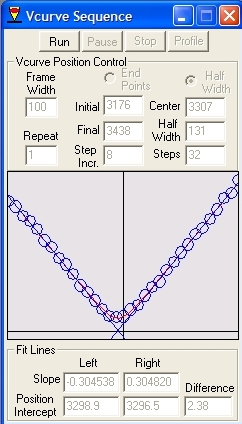
|
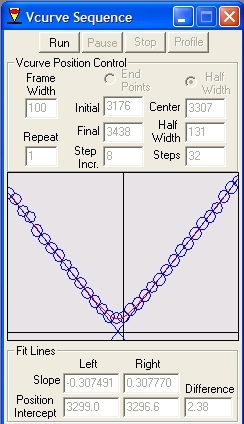
|
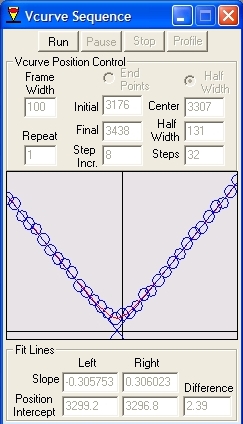
|
Optical Performance Evaluation Part 1-
CCD Inspector was used to measure the collimation, FWHM, tilt and curvature of the imaging field. Using a 2Mp CCD with a physical size of 8.9mm x 11.8mm this falls well inside the advertised 52mm corrected field so I expected very little curvature. Though it's always good to use as many stars as possible for these measurements, this was taken during galaxy season which is known for sparse star fields so an effort was made to get a field where the stars were spread out for better area sampling. The CCD Inspector results show an impressive flat field as expected with a small CCD sensor in addition to excellent collimation. Additional images taken on other targets resulted in similar FWHM, curvature varying from 5% to 8% depending on filter user and tilts ranging from 0.0 to 0.2". The FWHM values will vary depending on local seeing conditions. These measurements were from the galaxy image NGC4725 that follows.

Curvature measurements using a calibrated sum of 22 images

3-D curvature plane

3-D curvature plane rotated for side view to show a very flat plane
Optical Performance Evaluation Part 2 - What counts the most...the visual experience.
Putting all specifications and theories aside, the visual performance is the ultimate judge. This is an image of galaxy NGC4725 taken in May 2009. The nights seeing conditions this was taken in allowed the capture of good details and the focus was done every 3rd 10 minute frame. Note the mild diffraction spikes on the brighter stars from the secondary spiders.
Click on the image to open a separate page for details and larger images.
In Conclusion-
The initial wait was 3 months longer but that was the risk I accepted being one of the first on line. But, the wait was well worth it and I highly recommend this OTA to anyone who is looking for a Ritchey-Chrétien at a very reasonable price. Sure, there are now Chinese R/C OTA's appearing on the market that cost less than an American built R/C, but reports I have seen so far indicate the rear mounted focusers on these R/C's need long extension tubes to reach prime focus with a camera. This usually can and does lead to flexure. This is one advantage of the high precision secondary mirror focuser the RC10 (and other high quality R/C's) use over the Chinese made R/C's.
My only wish list item would be to provide a controllable duty cycle on the dew heater instead of the on/off choice. Having be doing electronic work all my life I may locate the pin outs on the connector and make an add-on harness to attach my Kendrick dew controller. Not that I needed it, but if I ever do I can have the ability to control it. The other wish list item I would like to have are adjustable fan speeds. One night of imaging the mirror developed dew rapidly when I left the fan running. I suspect the mirror surface was cooled too much. But that happened only once since I had the OTA.
After using this OTA for a couple of months now with no problems and very satisfied with the performance, I can easily say it was one of those purchases that I'm glad to have made and have no second thoughts about it. Often in this hobby you get what you pay for and the DSI RC10C is a lovely piece of work, precision and high performance combined in a portable OTA that's worth every penny.
October 2010 - Over 1 year later-
I have had this astrograph over 1 year and I have absolutely no complaints. The collimation held perfectly all this time. The fit and finish
still is excellent. The fans are still very quiet and the outer body finishing still smooth and with a great shine. The optics are performing excellent as is the focuser and electronics. The focus holds very good even on nights with large temperature swings. I do refocus every 40 minutes and the focuser changes are either none to maybe a few ticks through the night depending on temperature stability and sky temperature.
I posted a page on how to clean the optics here after I discovered damp leaves inside the OTA body from a windy night of imaging and dried residue was left on the primary mirror. Overall, this OTA is still worth every cent and I consider this one of my smarter purchases in this hobby.
